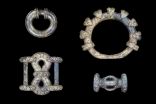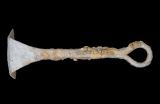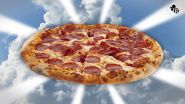(Press-News.org) University of Leicester archaeologists have made a "once-in-a-career" discovery of the decorated bronze remains of an Iron Age chariot.
A team from the University's School of Archaeology and Ancient History has unearthed a hoard of rare bronze fittings from a 2nd or 3rd century BC chariot which appears to have been buried as a religious offering.
The archaeologists found the remains during their ongoing excavation of the Burrough Hill Iron Age hillfort, near Melton Mowbray, Leicestershire.
The School has led a 5-year project there since 2010, giving archaeology students and volunteers valuable experience of archaeological excavations.
Burrough Hill is owned by the education charity, the Ernest Cook Trust, which has also funded site tours and school visits to the excavation.
While digging a large, deep pit near the remains of a house within the hillfort, a group of four students found a piece of bronze in the ground – before uncovering a concentration of further parts very nearby.
Taken together, the pieces are easily recognisable as a matching set of bronze fittings from a mid to late Iron Age chariot. As a group of two or more base metal prehistoric artefacts this assemblage is covered under the Treasure Act.
After careful cleaning, decorative patterns are clearly visible in the metalwork – including a triskele motif showing three waving lines, similar to the flag of the Isle of Man.
Nora Battermann, from University of Leicester was one of the students who made the discovery. She said: "Realising that I was actually uncovering a hoard that was carefully placed there hundreds of years ago made it the find of a lifetime. Looking at the objects now they have been cleaned makes me even more proud, and I can't wait for them to go on display."
The pieces appear to have been gathered in a box, before being planted in the ground upon a layer of cereal chaff and burnt as part of a religious ritual. The chaff might have doubled as a "cushion" for the box and also the fuel for the fire.
After the burning, the entire deposit was covered by a layer of burnt cinder and slag – where it lay undisturbed for more than 2200 years until the team uncovered it.
The archaeologists believe the chariot would have belonged to a high-status individual, such as a "noble" or "warrior".
The team believe the burial may have taken place to mark a new season, or the final closure or dismantling of a house at the fort.
Dr Jeremy Taylor, Lecturer in Landscape Archaeology at the University's School of Archaeology and Ancient History and co-director of the Burrough Hill field project, said: "This is a matching set of highly-decorated bronze fittings from an Iron Age chariot – probably from the 2nd or 3rd century BC.
"This is the most remarkable discovery of material we made at Burrough Hill in the five years we worked on the site. This is a very rare discovery, and a strong sign of the prestige of the site.
"The atmosphere at the dig on the day was a mix of 'tremendously excited' and 'slightly shell-shocked'. I have been excavating for 25 years and I have never found one of these pieces - let alone a whole set. It is a once-in-a-career discovery."
John Thomas, co-director of the project added "It looks like it was a matching set of parts that was collected and placed in a box as an offering, before being placed in the ground. Iron tools were placed around the box before it was then burnt, and covered in a thick layer of cinder and slag.
"The function of the iron tools is a bit of a mystery, but given the equestrian nature of the hoard, it is possible that they were associated with horse grooming. One piece in particular has characteristics of a modern curry comb, while two curved blades may have been used to maintain horses hooves or manufacture harness parts."
The parts have been taken to the University of Leicester's School of Archaeology and Ancient History for further analysis – and the archaeologists hope they will be put on public display in due course.
Before then, there will be a temporary display of the objects at the Melton Carnegie Museum, Melton Mowbray, Leicestershire, from Saturday October 18th until Saturday December 13th.
INFORMATION:
The Burrough Hill excavation was undertaken to a detailed research design with the consent of the Department for Culture Media and Sport (advised by English Heritage), and the permission of the Ernest Cook Trust (landowners), and Leicestershire County Council (site management).
Notes to editors:
For more information, please contact either:
Dr Jeremy Taylor on 0116 223 1804 or at: jt38@le.ac.uk
Or
Mr. John Thomas on 0116 252 5038 or at jst6@le.ac.uk
More information about the Burrough Hill dig can be found at: http://www2.le.ac.uk/departments/archaeology/research/projects/burrough-hill
IMAGES OF CHARIOT FITTINGS AVAILABLE TO DOWNLOAD AT: https://www.dropbox.com/sh/rre3t88ibtznajf/AABfEshXugKOTLaI4sY5pU3ya?dl=0
Archaeologists describe being 'shell-shocked' by enormity of discovery
Students from University of Leicester make discovery
Rare set of decorated chariot fittings appear to have been buried as a religious offering
University of Leicester archaeologists discover bronze remains of Iron Age chariot
Team uncovers a matching set of decorated bronze parts from a 2nd or 3rd century BC Celtic chariot at Burrough Hill Iron Age hillfort
2014-10-14
ELSE PRESS RELEASES FROM THIS DATE:
Disputed theory on Parkinson's origin strengthened
2014-10-14
Parkinson's disease is strongly linked to the degeneration of the brain's movement center. In the last decade, the question of where the disease begins has led researchers to a different part of the human anatomy. In 2003, the German neuropathologist Heiko Braak presented a theory suggesting that the disease begins in the gut and spreads to the brain. The idea has since, despite vocal critics, gained a lot of ground. Researchers at Lund University in Sweden now present the first direct evidence that the disease can actually migrate from the gut to the brain.
The so-called ...
Magnetic superconductor: Strange bedfellows
2014-10-14
Chemists at Ludwig-Maximilias-Universitaet (LMU) in Munich have synthesized a ferromagnetic superconducting compound that is amenable to chemical modification, opening the route to detailed studies of this rare combination of physical properties.
Superconductivity and ferromagnetism – the "normal" form of magnetism, such as that found in the familiar horseshoe magnet – are like chalk and cheese: They generally don't go together. Ferromagnets are magnetic because the parallel alignment of adjacent electron spins in the iron atoms generates a strong internal ...
Rising sea levels of 1.8 meters in worst-case scenario
2014-10-14
The climate is getting warmer, the ice sheets are melting and sea levels are rising – but how much? The report of the UN's Intergovernmental Panel on Climate Change (IPCC) in 2013 was based on the best available estimates of future sea levels, but the panel was not able to come up with an upper limit for sea level rise within this century. Now researchers from the Niels Bohr Institute and their colleagues have calculated the risk for a worst-case scenario. The results indicate that at worst, the sea level would rise a maximum of 1.8 meters. The results are published ...
The chemistry of pizza (video)
2014-10-14
WASHINGTON, Oct. 13, 2014 — Whether it's a plain cheese, a deep-dish stacked with meats or a thin-crust veggie delight, there's just something about pizza that makes it delicious. There's a lot of chemistry that goes into everything from dough to sauce to toppings to, of course, cheese. There's also a very specific chemical reaction at work on every single slice, no matter what toppings you choose. Check out the latest episode here: http://youtu.be/tOkCgAwhh9U.
Subscribe to the series at Reactions YouTube, and follow us on Twitter @ACSreactions to be the first to ...
Oral drug reduces formation of precancerous polyps in the colon, UB researchers find
2014-10-14
BUFFALO, N.Y. — An oral biologic medication has successfully treated chronic, precancerous inflammation in the intestine, according to results of an animal study authored by an MD/PhD student in the University at Buffalo School of Medicine and Biomedical Sciences.
The study is featured on the cover of the current issue of Cancer Research; it was published online ahead of print in September. The journal's editors characterized the study's findings as "striking."
Inflammatory cells in the colon, or polyps, are very common after the age of 50. The average 60-year-old ...
NASA satellite sees wind shear affecting Tropical Storm Vongfong
2014-10-14
Tropical Storm Vongfong continues to weaken as it tracks across the big islands of Japan, and NASA satellite data showed that westerly wind shear is taking its toll on the storm's structure.
On Oct. 12 at 0500 UTC (1 a.m. EDT), the MODIS instrument aboard NASA's Aqua satellite captured an image of Tropical Storm Vongfong approaching Japan. Despite weakening to a tropical storm, Vongfong still appeared to have an eye as its northeastern quadrant blanketed the large island of Kyushu, Japan. By 11 a.m. EDT, Maximum sustained winds had dropped to 55 knots (63 mph/102 kph). ...
Tropical Storm Gonzalo triggered many warnings in Eastern Caribbean
2014-10-14
The Eastern Caribbean islands were getting the brunt of Tropical Storm Gonzalo as the storm slowly moved through on Oct. 13. NASA's Terra satellite and NOAA's GOES-East satellite provided data on the storm. Gonzalo is the sixth named storm in the Atlantic Ocean Hurricane Season.
On Oct. 12 at 15:00 UTC (11:00 a.m. EDT), NASA's Terra satellite flew over Tropical Storm Gonzalo while it moved over the Lesser Antilles. The MODIS instrument captured a visible image of the storm that showed a concentration of strong thunderstorms around the center of circulation and in a thick ...
Satellites confirm Fay weakened to a Tropical Storm
2014-10-14
The fifth named Atlantic storm didn't maintain hurricane status long. Fay became a hurricane late on Oct. 12 and by early on Oct. 13, had weakened back to a tropical storm.
A visible image from NOAA's GOES-East satellite on Oct. 13 at 1145 UTC (7:45 a.m. EDT) showed Tropical Storm Fay northeast of Bermuda and Tropical Storm Gonzalo over the Lesser Antilles. Fay appeared circular, but didn't have the signature shape of a tropical storm like Gonzalo, with bands of thunderstorms spiraling into the center. The image was created by the NASA/NOAA GOES Project at NASA's Goddard ...
ORNL researchers make first observation of atoms moving inside bulk material
2014-10-14
OAK RIDGE, Tenn., Oct. 13, 2014 -- Researchers at the Department of Energy's Oak Ridge National Laboratory have obtained the first direct observations of atomic diffusion inside a bulk material. The research, which could be used to give unprecedented insight into the lifespan and properties of new materials, is published in the journal Physical Review Letters (06 October 2014, DOI: 10.1103/PhysRevLett.113.155501).
"This is the first time that anyone has directly imaged single dopant atoms moving around inside a material," said Rohan Mishra of Vanderbilt University who ...
Charged graphene gives DNA a stage to perform molecular gymnastics
2014-10-14
CHAMPAIGN, Ill. — When Illinois researchers set out to investigate a method to control how DNA moves through a tiny sequencing device, they did not know they were about to witness a display of molecular gymnastics.
Fast, accurate and affordable DNA sequencing is the first step toward personalized medicine. Threading a DNA molecule through a tiny hole, called a nanopore, in a sheet of graphene allows researchers to read the DNA sequence; however, they have limited control over how fast the DNA moves through the pore. In a new study published in the journal Nature ...
LAST 30 PRESS RELEASES:
Norbert Holtkamp appointed director of Fermi National Accelerator Laboratory
New agentic AI platform accelerates advanced optics design
Biologists discover neurons use physical signals — not electricity — to stabilize communication
Researchers discover that a hormone can access the brain by hitchhiking
University of Oklahoma researcher awarded funding to pursue AI-powered material design
Exploring how the visual system recovers following injury
Support for parents with infants at pediatric check-ups leads to better reading and math skills in elementary school
Kids’ behavioral health is a growing share of family health costs
Day & night: Cancer disrupts the brain’s natural rhythm
COVID-19 vaccination significantly reduces risk to pregnant women and baby
The role of vaccination in maternal and perinatal outcomes associated with COVID-19 in pregnancy
Mayo Clinic smartwatch system helps parents shorten and defuse children's severe tantrums early
Behavioral health spending spikes to 40% of all children’s health expenditures, nearly doubling in a decade
Digital cognitive behavioral treatment for generalized anxiety disorder
Expenditures for pediatric behavioral health care over time and estimated family financial burden
Air conditioning in nursing homes and mortality during extreme heat
The Alps to lose a record number of glaciers in the next decade
What makes a good proton conductor?
New science reporting guide published for journalists in Bulgaria
New international study reveals major survival gaps among children with cancer
New science reporting guide published for journalists in Turkey
Scientists develop a smarter mRNA therapy that knows which cells to target
Neuroanatomy-informed brain–machine hybrid intelligence for robust acoustic target detection
Eight SwRI hydrogen projects funded by ENERGYWERX
The Lundquist Institute and its start-up company Vitalex Biosciences Announces Strategic Advancement of Second-Generation fungal Vaccine VXV-01 through Phase 1 Trials under $40 Million Competitive Con
Fine particles in pollution are associated with early signs of autoimmune disease
Review article | Towards a Global Ground-Based Earth Observatory (GGBEO): Leveraging existing systems and networks
Penn and UMich create world’s smallest programmable, autonomous robots
Cleveland researchers launch first major study to address ‘hidden performance killer’ in athletes
To connect across politics, try saying what you oppose
[Press-News.org] University of Leicester archaeologists discover bronze remains of Iron Age chariotTeam uncovers a matching set of decorated bronze parts from a 2nd or 3rd century BC Celtic chariot at Burrough Hill Iron Age hillfort









